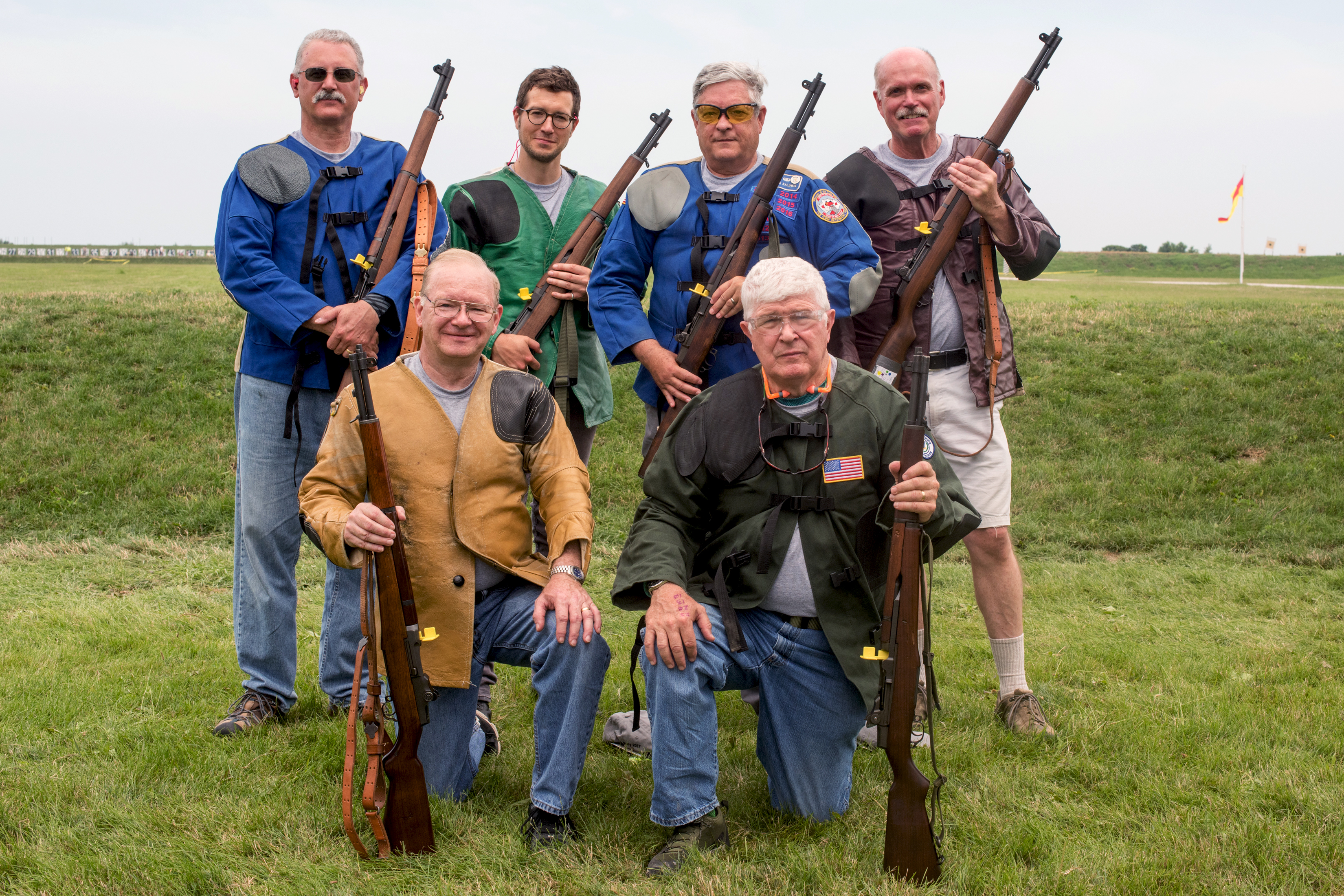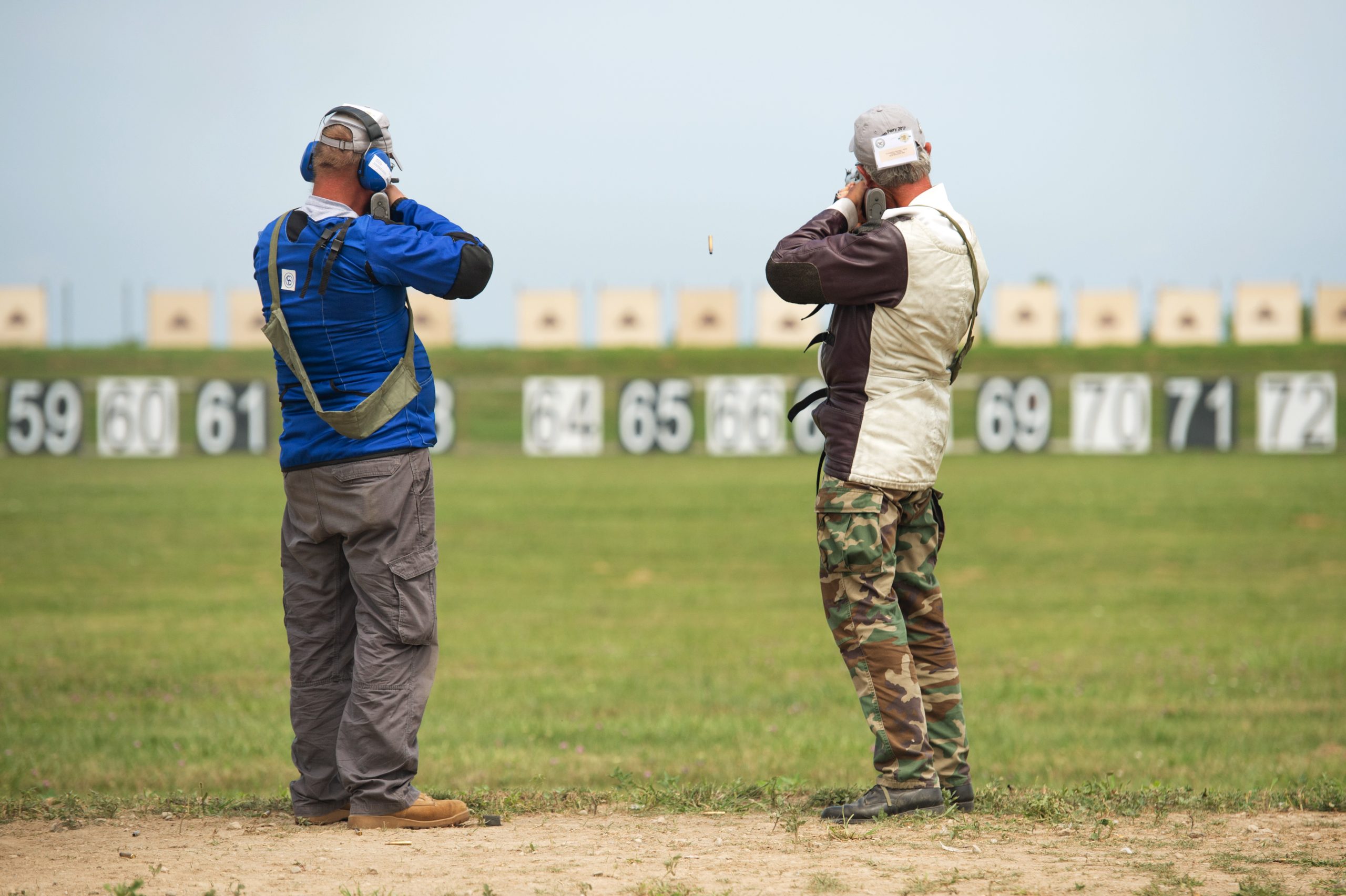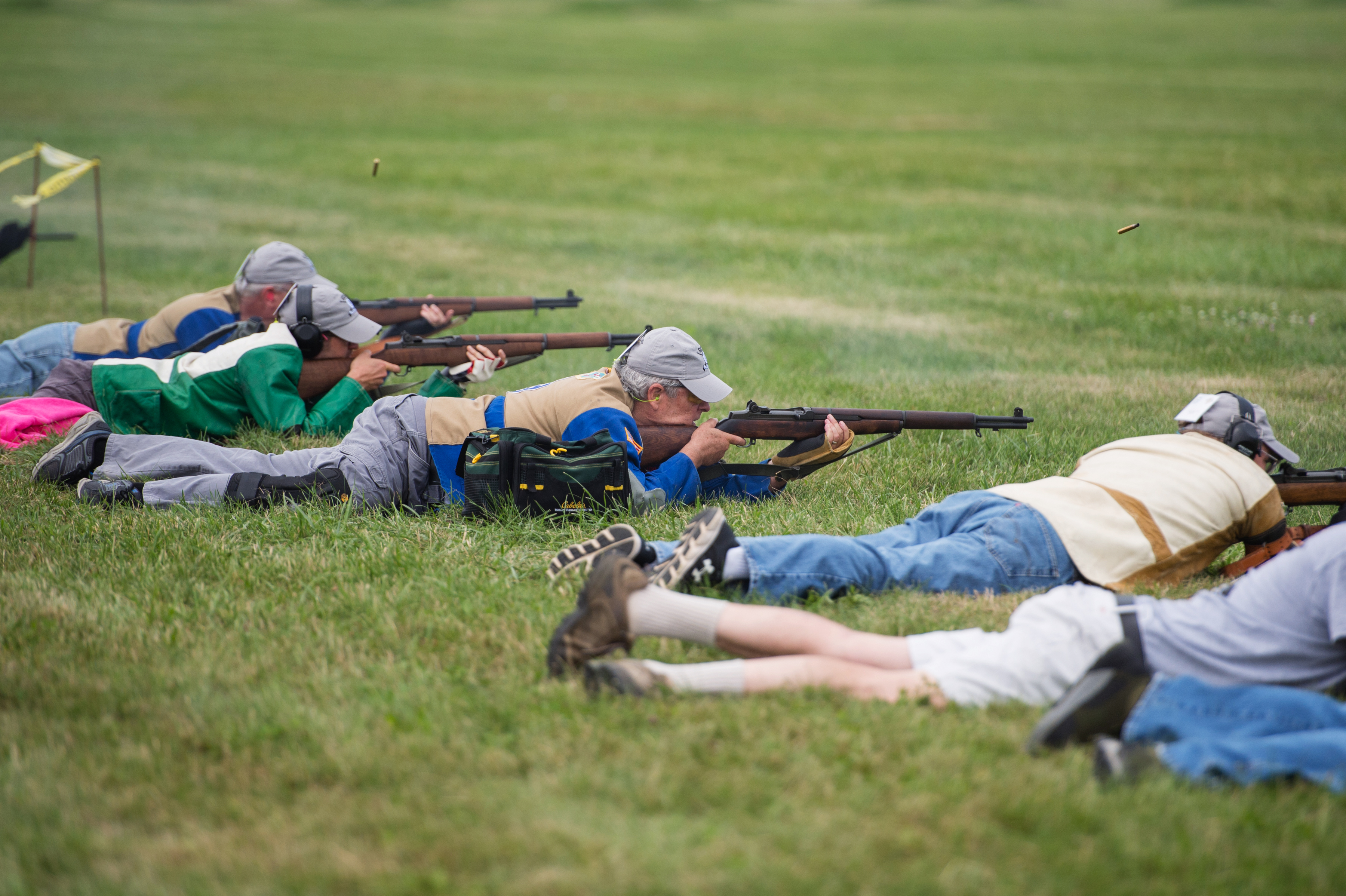John Walsh, a 36-year-old Brooklynite wearing a leather shooting jacket, tight jeans, and a gay pride button, is lying on the floor of a hotel room in rural Ohio with a World War II-era rifle, taking aim at the peephole in the door.
He wraps the sling of the M1 Garand around his forearm. His father, Bob Walsh, watches him tighten the strap as he had shown him. The idea is to distribute the heavy weapon’s weight throughout his upper body.
John slows his breathing to steady the rifle and relaxes his arm muscles. There should only be tension in his trigger finger during the split second before he takes a shot, his father tells him.
He pulls the trigger. The rifle makes a soft click as the firing pin hits the plastic practice round.
John is nervous. The next day he will take part in the biggest shooting competition of the year, the Civilian Marksmanship Program’s National Matches, and he hasn’t had much time to practice. It’s his first time competing on his father’s team, the Inglorious Blasters. He doesn’t want to let everyone down.
“My dad jokes that they drive 10 hours for 15 minutes of shooting and that puts on a lot of pressure,” John says later. “I didn’t want to embarrass my dad, and secondarily, I didn’t want to embarrass myself.”
This is why he is lying on the floor of a Travelodge. He is practicing dry-firing the rifle to work out the kinks in his technique.
The father and son are from Georgia but inhabit different worlds. Bob is a 63-year-old, conservative West Point graduate who recently retired from textile engineering for an airbag company and now coaches high school shooters in his extra time. Dental braces kept him from joining his high school wrestling team, so he joined the school’s shooting team and eventually became a champion marksman.

I’ve known John for years. He’s an avowed liberal who worked as a development manager for a literary organization in a hip New York City neighborhood and plays guitar in rock bands. Although his dad has been dragging him to ranges since he was a pre-teen, he’s a newcomer to shooting sports and his views on guns in America are complicated. He has left long and detailed screeds railing against gun violence on Facebook. He has sometimes questioned whether private gun ownership should even be allowed.
John joined his father’s team as a way to spend time with his dad — and to better understand why shooting was such a passionate part of his life. He invited me to join the team over a weekend in late July.
Though there are almost certainly more people at this competition whose views align with Bob Walsh than with his son, John isn’t totally out of place. That’s by design.
As the gun debate has grown increasingly polarized, the Civilian Marksmanship Program has stayed true to its mission to train shooters, especially young ones, while remaining apolitical. Unlike the National Rifle Association, it doesn’t sell memberships, charge dues, or lobby state and local officials. It’s like the Boy Scouts of America, but with guns.
The people who attend CMP National Matches geek-out on the equipment and technology they can use to better their scores, much like how golfers obsess over the newest putters and drivers. Some get up early and use binoculars to read the heat mirage steaming off the ground to get an idea of which way the wind is blowing off Lake Erie. A few even weigh the different powders that go into their ammunition to create custom rounds that compliment their shooting styles.
“There are gun nuts and gun nerds,” says Wayne, a 57-year-old member of the Inglorious Blasters who served in the Navy for eight years, and didn’t want The Trace to use his last name in this story. “At the National Matches, you’re going to see a bunch of gun nerds.”
Another Blaster, Rick Baldwin, is a 64-year-old retired Air Force colonel who has a stash of antique rifles going back to the 1800s that he keeps locked in a safe and rarely fires. Mike Curran, one of their best shooters, is a former Navy man and retired dentist whose wife is firmly anti-gun — but who practices with his M1 Garand whenever he can. The final member is Ray Holmes, 70. He served in the Army, and his teammates say is an encyclopedia of gun knowledge.
The Blasters have only been together for a few years. Their ambition is modest: to improve on their past performances. The contest they will compete in is the Infantry Trophy Team Match — or, as everyone here calls it, the “Rattle Battle.”
The goal is to simulate what it is like for an infantry squad to advance on a position, while firing. Most of the participants are civilians who shoot in local clubs. Some have an edge: they are active-duty military.
John didn’t serve in the military. He never figured he was the kind of guy who would get into a shooting competition. He was surprised to find that practicing, even without ammo, could be enjoyable.
“You turn your body into something that is completely balanced, and your brain into something that is balanced, too,” he says.
Last year, John played a supporting role to the team. He used binoculars to tell the Blasters how close their rounds were coming to targets, and he kept score. This year, he will be shooting with them.
“This is my first opportunity to say, ‘I’m am here. This is me. I know what to do.’”
The Civilian Marksmanship Program has its origins in the Spanish–American War. Theodore Roosevelt, a Rough Rider, came away from the conflict dismayed by the poor shooting ability of American troops. Congress created the CMP in 1903 with the goal of encouraging civilians to practice marksmanship. In 1996, the organization was spun off from the Department of Defense into the nonprofit Corporation for the Promotion of Rifle Practice and Firearms Safety.
The CMP does not accept federal funding, but it is given surplus military rifles and ammunition to sell in support of its mission.
Most of its sales come by way of one gun: the M1 Garand. The gas-fed, semiautomatic rifle allowed Allied troops to place eight well-aimed shots as fast as they could pull the trigger during World War II. General George Patton called it “the greatest battle implement ever devised.”
Roughly 15,000 are sold through the CMP each year. Earlier this year, the organization received word that 86,000 M1s from the Philippines are likely headed its way.
Even so, the long-term future of the sales program is uncertain. The CMP estimates that if it continues to sell the rifles at the current clip, its supply will run out in less than six years.
At this year’s National Matches in Ohio, there are over a dozen contests or awards dedicated to the M1 Garand alone. Many teams choose to shoot with the gun during the Rattle Battle out of respect for the firearm’s history.
The teams taking part come from all backgrounds.The all-Puerto Rican team competes against squads made up of soldiers and marines. Teams of teens and college students shoot alongside senior shooters. Many squads are mixed-gender.
As its name might suggest, the Infantry Trophy Match is just about always won by a commissioned military squad. In the nearly 100 years that the match has existed, a civilian team has bested the enlisted service members only twice.
The last civilian team to win the Rattle Battle was an under-20 squad from the Coalinga Rifle Club in California, in 2009.
“Camp Perry, if you’re involved in the high-power world, it’s the World Series of Shooting,” says Nelson Green, a member of that club.

It’s sunny the next morning on the range, but there is a cool breeze coming in off the lake. Family and friends sit in lawn chairs and watch from behind the shooting berm, a small hill where the competitors line up, shoot, and work their way down the range. Coolers filled with water and snacks are nearby. Shooters check their gear and chat about their rifles under the shade of trees, waiting to be called into action.
This wasn’t what John was expecting when he first came to the National Matches two years ago.
“It’s got the energy and verve of a track and field meet or golf match,” John says. “I kind of thought of gun owners as a bunch of good ol’ boys who would just be out there to shoot things up and have a good time. Which is essentially what it is, but it’s not rebel flags and people blasting Skynyrd out of the back of a pick-up truck.”
Steve Cooper, the CMP’s general manager at Camp Perry, walks through crowds of shooters, greeting people he knows. He ribs a few over their past performances and talks about how the teams have been shooting over the course of the day.
All the while, he keeps an eye out to make sure that everyone is following safety protocols. Throughout the year he holds small arms firing clinics and safety courses.
Plastic yellow flags are slid into the chamber of rifles not being used so they are impossible to fire and everyone knows they’re safe. If the flag is removed, which usually only happens when shooters line up for competition relays, the muzzle is always pointed away from people and down range.
“It’s a dangerous device, and we take it very seriously,” Cooper says. “You need to know that thing is lethal.”
Cooper says he can’t speak for the apolitical CMP, but he says he favors a licensing requirement demonstrating basic competency before an individual can buy a gun.
“I think it’s pretty much like driving a car. Maybe you’ve been driving grandpa’s car on his property for a long time but that doesn’t give you the right to take it out on a public road,” he says. “I know what I use guns for, and I don’t have a problem.”
At the competition, if a shooter breaks Cooper’s protocols, his or her entire team is disqualified.
Dan Lowe, 25, is a 2016 Olympic shooter and an Army specialist. The Rattle Battle, unlike many other shooting competitions, doesn’t leave any margin for error or mistake, he says. There are no “alibis” —chances to reshoot if something goes wrong, like a firing pin breaking.
“You have to live entirely for that moment,” Lowe says, “and you have to be as prepared as you can be.”
Part of that preparation is being aware of every aspect of your body, but relaxed and focused on the point of the barrel, Lowe says. A slight tremor can put a bullet off target by inches. So you need to slow your breathing, lower your heart rate, and calm your mind.
“For a lot of us, it’s our meditation,” Lowe says. “You’re not out there worrying about your bills or taxes or whatever. It keeps me centered and keeps me present.”
John hasn’t shot a rifle since his last outing with the Blasters. New York’s strict gun laws make practicing with an M1 almost impossible, but he probably wouldn’t have gone to the range much anyway. Now he is trying to catch up. He’s spending a lot of his down time on the air rifle range to practice his technique.
“There is this element of me wanting to do my dad proud,” he says. “He’s put in all this effort into showing me how to shoot well. I have this guy who has coached a lot of people, teaching me. I wanted to show him that it was worth the effort to teach me, not just because I’m his son, but because I’ve learned a thing or two.”
Around 1:00 in the afternoon, it is finally the Blasters turn to shoot. It’s hot. John and the rest of the crew, wearing thick shooting jackets to absorb rifle recoil and keep their aim steady, are sweating hard even before they begin.
They load their pockets with ammo cartridges and line up on the berm with half a dozen other teams, 600 yards from the targets. They lay down in the prone position. The muted pats of gloved hands against rifle barrels skip up and down the line as they adjust and readjust their sights and holds.
A dozen or so other teams are spread out along the berm. A woman over the loudspeaker yells, “Load and be ready!”
The field echoes with the clicks of clips locking into place. The first stage of the event is crucial. Hits are worth four times a much as in the final stage. Shooters have only 50 seconds to fire as many rounds as possible.
But John is having trouble. When he tries to push in his eight-bullet cartridge, the gun’s spring kicks the cartridge back out. The gun won’t load. It’s the one thing he didn’t practice.
The targets rise up far down range. Cries of “targets!” go up the line.
Bob, John’s father, begins shooting. So do Rick and Wayne. John still can’t get his cartridge to load. And he’s not the only one having trouble. On his first attempted shot, Mike’s firing pin breaks.
Mike is one of the team’s best shooters, but the malfunction is catastrophic. It can’t be fixed on the range.
Gunfire from hundreds of shots vibrate the air. The burnt smell of gunsmoke drifts on the wind.
When the 50 seconds expire, the team moves up to the next firing position, 100 yards down range. John manages to finally load his cartridge and is able to participate in the final three rounds, as the shooters move ever closer to the targets.
When the smoke clears, the Blasters are despondent. The team took fourth place in the Garand division last year. They don’t even bother to check their final score this time.
I did, later. Out of a field of 71 teams, the Blasters finished dead last.
John’s failure to load his weapon was costly. “While we practiced all sorts of things, like dry-firing, one of the things that did not seem wise to practice in a hotel room with a thirty-aught-six was loading it with live rounds,” he said later.
The Blasters pack up their gear and disperse around the camp. There’s hope that they might be able to redeem themselves during the individual Garand match tomorrow. John goes back to the air rifle range for more practice.
The next day, a stormfront blows in. Shooting is delayed because of lightning strikes. After a heavy breakfast and the prospect of waiting for hours in the rain for a break that might never come, the team decides to pack it in. A three-hour drive back to Dayton is ahead of them, along with the team’s annual ritual — a spaghetti dinner and subsequent discussion, over whiskey and cigars, about the state of conservative politics.
John hangs back with me. Later in the morning, the weather clears, and the individual Garand match is back on. John checks the trunk of the car and realizes his dad, who is already halfway to Dayton, has taken his M1.
“Damn,” John says, “I really wanted to get out there and shoot.”
[Photos: Dustin Franz for The Trace]
Correction: A previous version of this story said that Ray Holmes attended West Point. He went to Georgia Tech.



